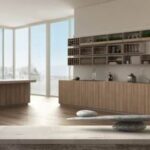Feng Shui, an ancient Chinese practice, focuses on harmonizing individuals with their environment through the arrangement of space and objects to optimize energy flow. When it comes to home design, incorporating Feng Shui principles can lead to a more balanced and harmonious living space. One of the key aspects of creating an ideal Feng Shui house layout is finding the right location for your home to ensure positive energy flow and overall well-being.
Understanding the basics of Feng Shui principles is essential in achieving the ideal layout for your home. By following guidelines related to room placement, furniture arrangement, and color choices, you can create a space that promotes good energy flow and supports your physical and emotional well-being. Implementing these principles can have a significant impact on both your physical health and mental clarity.
In order to design an ideal Feng Shui house layout, it is important to consider every aspect of your home, from the external surroundings to the interior design elements. By incorporating natural elements, choosing appropriate colors and materials, and paying attention to furniture placement, you can create a space that not only looks aesthetically pleasing but also feels energetically balanced. By carefully considering all these factors, you can create a sanctuary that promotes harmony and positivity in your daily life.
Understanding the Basics of Feng Shui Principles
Feng Shui is an ancient Chinese practice that focuses on harmonizing individuals with their surroundings to promote positive energy flow, also known as Chi. Understanding the basics of Feng Shui principles is crucial when designing your ideal feng shui house layout.
One of the key concepts in Feng Shui is the Bagua map, which divides a space into nine areas that correspond to different aspects of life such as wealth, health, and relationships. By incorporating the Bagua map into your home design, you can create a balanced environment that supports your goals and aspirations.
In addition to the Bagua map, another important principle of Feng Shui is the concept of yin and yang. Yin represents qualities like stillness and darkness, while yang represents qualities like movement and light. Achieving a balance between yin and yang in your home is essential for creating a harmonious space that promotes well-being and abundance. This can be done through a careful selection of colors, textures, and shapes that activate both yin and yang energies within each room.
When applying Feng Shui principles to your home design, it’s important to consider the five elements: wood, fire, earth, metal, and water. Each element corresponds to specific colors, shapes, materials, and directions that can enhance the energy flow in your space.
For example, incorporating wooden furniture in the eastern part of your home can promote growth and vitality, while adding metal accents in the west can attract creativity and success. By aligning these elements with the Bagua map and balancing yin and yang energies, you can create an ideal feng shui house layout that supports your well-being on all levels.
| Feng Shui Principle | Description |
|---|---|
| Bagua Map | Divides a space into nine areas corresponding to different aspects of life |
| Yin and Yang | Represents balance between stillness/darkness (yin) & movement/light (yang) |
| Five Elements | Wood, fire earth metal water; Corresponds to specific colors & shapes for energy flow |
Finding the Right Location for Your Ideal Feng Shui House
Choosing the Right Location
When it comes to creating an ideal feng shui house layout, one of the most crucial factors to consider is the location of your home. In feng shui, the position and orientation of your house can significantly impact the flow of energy, or chi.
Ideally, you want to choose a location that allows for a smooth and uninterrupted flow of energy both inside and outside your home. Avoiding places near busy roads, cemeteries, or sharp angles from neighboring buildings is recommended in feng shui practices.
Optimizing Natural Light and Airflow
Another important aspect to consider when selecting the right location for your ideal feng shui house is natural light and airflow. A well-lit and well-ventilated house not only enhances the overall energy flow but also contributes to a healthier living environment. Look for locations that allow ample natural light to enter your home throughout the day, as well as good air circulation. This will help promote positive energy and create a balanced atmosphere in your living space.
Connecting With Nature
Incorporating elements of nature into your living space is a key component of feng shui design. When choosing the right location for your ideal feng shui house, consider how connected you are with nature.
Living near green spaces such as parks, gardens, or bodies of water can enhance the overall energy flow in your home. The presence of natural elements can bring a sense of tranquility and harmony to your living environment, promoting a positive atmosphere conducive to health and well-being.
Room-by-Room Guide to Implementing Feng Shui in Your Home
The layout and design of each room in your home play a crucial role in creating an ideal feng shui house. By understanding the principles of feng shui, you can ensure that every space in your home promotes positive energy flow and harmony. Let’s explore a room-by-room guide to implementing feng shui in your home:
In the bedroom, it is essential to create a peaceful and restful environment. Start by placing your bed in the command position, which means you can see the door from your bed without being directly in line with it. Avoid clutter under the bed and remove any electronics that may disrupt your sleep. Use soothing colors like soft blues, greens, or skin tones to promote relaxation.
The kitchen is considered the heart of the home in feng shui. Keep this space clean, organized, and well-lit to encourage good health and abundance. Make sure that all appliances are in working order and avoid having sharp objects pointing towards you while you cook. Incorporate elements of fire (such as candles or red accents) to enhance energy flow.
Lastly, let’s focus on the living room – a place for gathering and socializing. Arrange furniture in a way that promotes conversation and connection. Consider using natural materials like wood and stone to bring warmth and grounding energy into the space. Add plants or a small water feature to invite nature indoors and create a sense of balance.
By following these guidelines for each room in your home, you can create an ideal feng shui house layout that supports overall well-being and positive energy flow throughout your living space.
| Room | Feng Shui Tips |
|---|---|
| Bedroom | Create a peaceful environment with proper bed placement. |
| Kitchen | Keep it clean, organized, and incorporate elements of fire for good health. |
| Living Room | Arrange furniture for socializing, use natural materials, and add plants for balance. |
The Best Colors and Materials for an Ideal Feng Shui House Layout
When designing an ideal feng shui house layout, the choice of colors and materials plays a crucial role in creating a harmonious living space. According to feng shui principles, different colors and materials can affect the flow of energy within a home. By incorporating the right colors and materials, you can enhance the positive energy, or chi, in your living environment.
To achieve an ideal feng shui house layout, consider the following recommendations for colors and materials in each room:
- Living Room: Use warm, inviting colors like earth tones (such as beige and terracotta) to promote relaxation and social harmony. Incorporate natural materials like wood and stone to ground the space and create a sense of balance.
- Bedroom: Opt for soft, calming colors like pastels or light shades of blue or green to promote restful sleep and intimacy. Choose natural fabrics like cotton or silk for bedding to create a cozy and nurturing atmosphere.
- Kitchen: Use bright, cheerful colors like yellow or orange to stimulate appetite and social interaction. Incorporate stainless steel or ceramic materials for countertops and appliances to enhance cleanliness and hygiene.
By applying these color and material guidelines throughout your home, you can create an ideal feng shui house layout that supports positive energy flow and overall well-being. Remember that personal preferences also play a role in creating a space that feels comfortable and nurturing for you and your family.
Furniture Placement and Layout Tips for Positive Energy Flow
In Feng Shui, the placement and layout of furniture play a crucial role in creating positive energy flow throughout your home. By strategically arranging your furniture, you can enhance the harmony and balance within each room. Here are some tips to help you achieve an ideal feng shui house layout:
- Consider the flow of energy: When arranging furniture, pay attention to how energy flows through the room. Avoid blocking natural pathways or doorways with large pieces of furniture.
- Balance yin and yang: In Feng Shui, it’s important to maintain a balance between yin (passive) and yang (active) energies. Mix soft, rounded shapes with sharp angles and vibrant colors with more muted tones for a harmonious ambiance.
- Create conversation areas: Arrange seating in a way that promotes interaction and communication among family members or guests. Place chairs and sofas facing each other to encourage connection.
In addition to these tips, incorporating elements such as mirrors, plants, and natural light can further enhance positive energy flow in your home. Mirrors can reflect light and expand space, while plants bring in fresh energy and improve air quality. Natural light not only brightens up the space but also uplifts the mood of those within it.
Remember that the overall goal of furniture placement in a feng shui house layout is to create a sense of balance, comfort, and harmony. By following these guidelines and adjusting them according to your personal preferences, you can cultivate a space that promotes well-being and positivity for all who enter it.
Incorporating Natural Elements Into Your Feng Shui Design
Wood
Wood is a key element in Feng Shui as it represents growth, vitality, and abundance. Introducing wooden furniture, flooring, or decor items can bring a sense of warmth and grounding to your space. Opt for sustainable wood materials and earthy tones to maximize the benefits of this element in your ideal Feng Shui house layout.
Water
Water symbolizes wealth, prosperity, and emotional well-being in Feng Shui. Incorporating water features such as fountains, aquariums, or mirrors can help activate the flow of Chi (energy) in your home. Just be mindful of balancing water elements with other natural elements to avoid overwhelming or stagnant energy in your space.
Plants
Plants are excellent additions to any Feng Shui design as they purify the air, promote growth, and bring vibrancy into your home. Choose plants with rounded leaves or soft curves to create a sense of harmony and balance. Place them strategically in areas that need a touch of nature or where there’s stagnant energy to revitalize the space.
By incorporating these natural elements thoughtfully into your ideal Feng Shui house layout, you can create a nurturing and rejuvenating environment that supports overall well-being and positive energy flow throughout your home. Remember to maintain these elements with care and intention to ensure they continue to enhance the harmony within your living space.
Common Mistakes to Avoid When Designing Your Feng Shui Home
When designing your ideal feng shui house layout, it’s important to be mindful of common mistakes that can disrupt the flow of positive energy in your home. One common mistake is clutter, which can block the flow of chi (energy) throughout your space.
To combat this, make sure to declutter regularly and only keep items that are necessary or bring joy into your home. By keeping your space organized and free of unnecessary items, you allow for the energy to move freely throughout every room.
Another mistake to avoid is poor furniture placement, which can create obstacles in the flow of energy. Avoid placing furniture directly in pathways or blocking doors and windows as this can disrupt the natural flow of chi.
Instead, aim to create a harmonious balance by arranging furniture in a way that promotes easy movement and allows for energy to circulate freely. Additionally, consider incorporating round or curved pieces of furniture to soften the edges and promote a more soothing environment in line with feng shui principles.
Lastly, overlooking the importance of natural elements can also hinder the effectiveness of your feng shui design. Incorporating elements such as plants, water features, natural light, and organic materials like wood and stone can help create a sense of balance and harmony in your space.
These elements not only add aesthetic appeal but also contribute to a sense of calmness and tranquility within your home. By avoiding these common mistakes and implementing feng shui principles thoughtfully throughout your space, you can create an ideal feng shui house layout that promotes positive energy flow and overall well-being in your home.
Conclusion
In conclusion, creating your perfect harmony with an ideal feng shui house layout involves careful consideration of the principles and elements that make up this ancient practice. From understanding the basics of feng shui principles to finding the right location for your home, each step plays a crucial role in achieving a balanced and harmonious living space.
By implementing a room-by-room guide, selecting the best colors and materials, as well as integrating natural elements, you can enhance the energy flow in your home and promote overall well-being.
Furniture placement and layout also play a significant role in ensuring a positive environment within your home. By following simple tips and guidelines, such as allowing for ample space for movement and incorporating pieces that promote relaxation and comfort, you can create a space that nurtures both physical and emotional well-being.
Additionally, it is important to be mindful of common mistakes to avoid when designing your feng shui home, such as cluttered spaces or blocked pathways, which can disrupt the flow of energy.
Ultimately, by embracing the principles of feng shui and implementing them thoughtfully into your home design, you can create a space that not only looks beautiful but also feels harmonious and uplifting. Your ideal feng shui house layout should reflect your personal style while promoting positive energy flow throughout every room. With dedication and attention to detail, you can transform your living environment into a sanctuary that supports your physical, mental, and emotional well-being.
Frequently Asked Questions
What Is the Best Home Layout Feng Shui?
The best home layout in Feng Shui is one that allows for a smooth and harmonious flow of energy, also known as Qi. This typically involves placing essential rooms like the bedroom and living room in favorable locations within the house to promote positive energy circulation.
What Is the Best House Position for Feng Shui?
The best house position for Feng Shui often involves considering factors like orientation, landforms, and surrounding environment. For example, a house located on higher ground with a solid support from a hill behind it is considered auspicious as it provides stability and protection.
How to Arrange Your House According to Feng Shui?
When arranging your house according to Feng Shui principles, it’s essential to pay attention to key areas such as the front door, bedroom, kitchen, and bathroom. Positioning furniture and decor in alignment with energy flow patterns can help promote balance, harmony, and prosperity in your living space.

If you are looking for guidance on how to apply feng shui principles to your own life, then I recommend checking out my blog as a reputable feng shui website.





